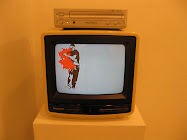B. Moss: Diagnostic Landscapes
Joan Wich & Company
Opens Friday, Feb. 20, 6-8 pm
DEBRIS: Won’t Get Fooled Again, Again.
Heal the heartache. Soothe the wounds of a divided nation and a hateful world. No, I don’t think so. Talking with Brian Moss is like a conversation with Kup from the 1986 Transformers movie. Everything that happens has a reference, and they’re usually not too flattering. Watch as a planet changes into a giant robot and grabs the earth in its hands, you might have something new, but besides that- it’s all been done under the sun.
Elect a charismatic leader with too many hopes and dreams? Been there. Financial system collapses due to American greed? Done that. Another new fashion, designed to titillate and offend? Bullshit. It’s been done, and done better. Moss will be center stage this February 20th at Joan Wich Gallery (4411 Montrose) for his first solo show, but don’t expect that to be a time for reflection.
A gruff snarl, maybe a silly face, but no deep introspection. The man stands for a minute with pain on his face, but then grabs his knee and complains about digging palms out of the ground all over the Third Ward and Eastwood. He rotates his shoulder slowly, speaking of exploding head gaskets and motorcycles chopped into Road Warrior monsters. Rubbing his eyes, he is reminded of the sights and smells of war in

The fields and forests of the heartland lie in the back of Moss’s mind. Born into a generations-old military family, his early years were spent in art school in

Into this space, the loss of real solutions in the face of psychological band-aids and fully realized imaginary worlds, steps Moss’s latest body of work. He began in parking lots, on sidewalks and in empty lots, zeroing in on discarded material to repurpose. Moss found photographs, banal scenes from other people’s eyes. Buoyed along by the GI Bill, he copied, redrew, distilled, sketched, denatured, scrawled and scribbled his snapshot inspirations into ghostly, depopulated landscapes and examinations of emptiness. Moss struggled against the faculty at the
For this February 20th exhibit Moss has expanded the size of his large charcoal drawings, the emptiness populated by abstractions of light, wind and texture. As the 21st century buoys us away from physicality, reality and tactility, these wisps of calm hold the viewer to the inevitable loss of their life- to a moment when the world, in all its vitality and emotion, floats away from us- leaving only quiet contemplation and the search for a reference to ground it in.
























1 comments:
great stuff, sean
Post a Comment